You know those parties where guests give five minute presentations on a topic of their choice? I love them! They’re like a live version of the YouTube videos I watch where the host does a deep dive on the history of a random pop culture topic, like the cultural significance and legacy of Hostess Ninja Turtle Pies. (“Fresh from the sewers to you,” dear lord.) Only these bite-sized talks are commercial free and given by people you know, not the disembodied voice of some guy. You get to learn about the kinds of things your friends are really passionate about, as opposed to a normal party with normal conversations about why they hate their job or agreeing that [insert any news story from 2025] is a real tragedy with profound consequences.
I went to one of these parties recently. The presentations were a nice mix of informative and absurd. Anime was well-represented. My favorite talk of the night was on which Pokémon the presenter would want to get high with. Her top choice was Chansey, based mostly on vibes.
I decided to go informative on an absurd topic, one I’ve referenced in this newsletter multiple times. Since you didn’t get to see it, here are the slides and commentary from my presentation, adapted for this newsletter. Reader, welcome to my favorite pop culture rabbit hole…
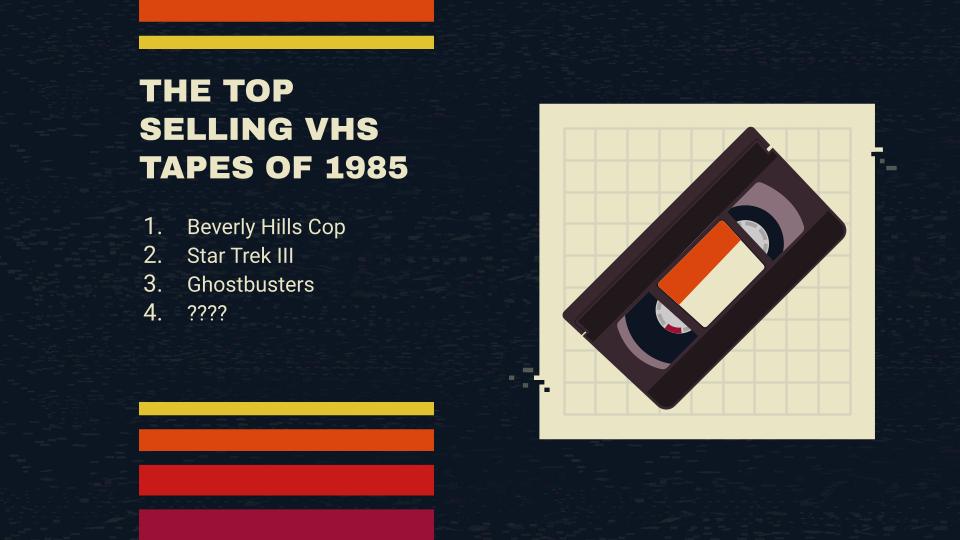
What you see above is a very popular bit of Hollywood trivia, like the name of the sled in Citizen Kane. Everyone knows the answer to, “What is the fourth best-selling VHS tape of 1985?” Go ahead and yell it at your computer. Ready? 1… 2… 3…
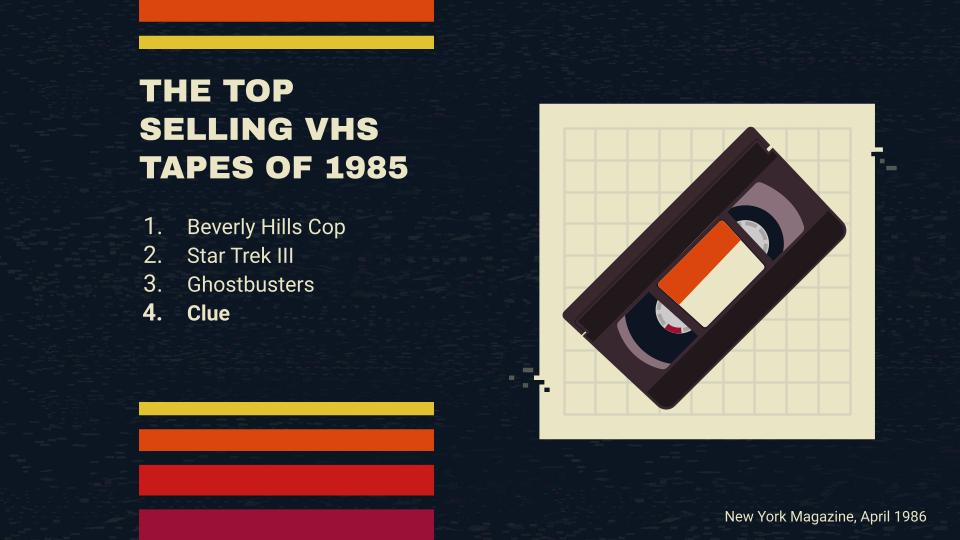
I have no idea if you actually screamed “Clue,” but I assume you did, because the answer is SO obvious!!! However, as all cinemaheads like yourself know, the VHS tape of Clue, the Tim Curry cult classic, wasn’t released until 1986. So, what Clue was the fourth best-selling VHS tape of 1985?
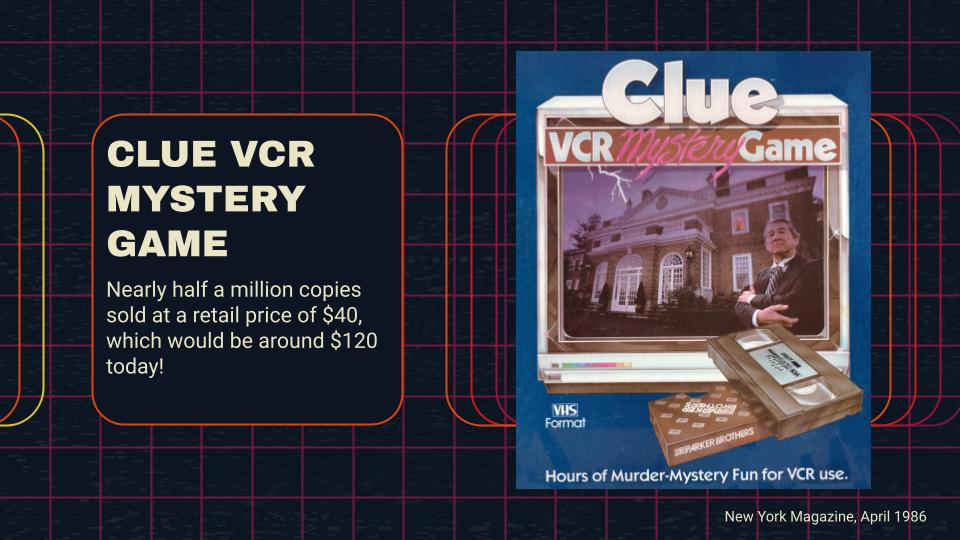
Yes, real (old) ones know I’m talking about Clue: VCR Mystery Game. The board game sold nearly 500,000 copies at a retail price of $40 (or $120 in 2025 dollars), meaning Park Brothers made a killing off this “interactive” murder-mystery experience. If you want to learn more about Clue: VCR Mystery Game and the Boston actors who became momentarily famous from its success, check out this YouTube documentary. We’re going more broadly with the topic…

We’re talking about VCR board games! I’m obsessed with these games for a few reasons, none of which has to do with the quality of the actual gameplay. I enjoy the over-the-top acting, the overly-complex rules, and the overtly cash-grabby pop culture tie-ins. But what I really love about them is how they’re trying to bridge the gap between tabletop games and interactive “video” games in an awkward, but charmingly inventive way.
Oh, I’m getting ahead of myself. You might be wondering a pretty basic question if you’re young enough to not have any recurring digestive problems…
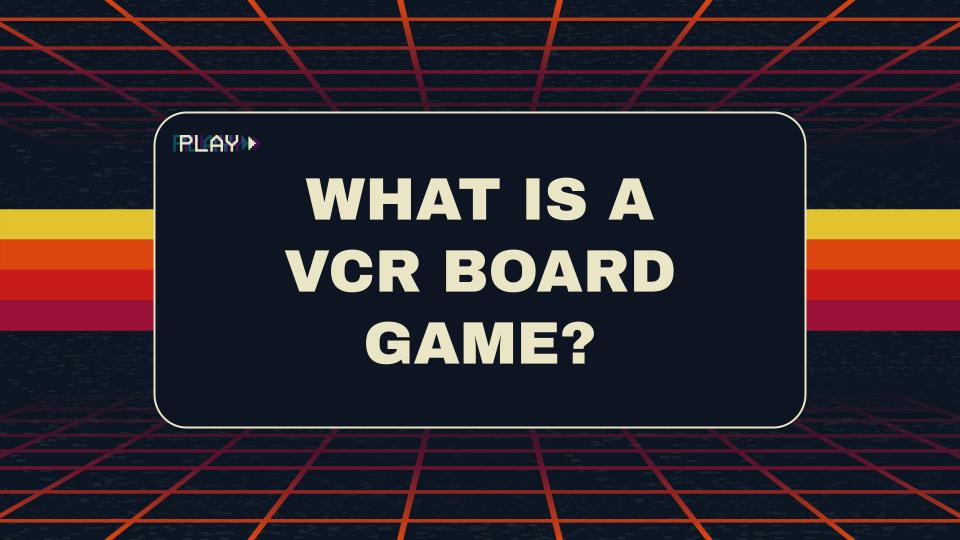
What even is a VCR board game? I’m so glad you asked. It’s my favorite question in the world to answer.
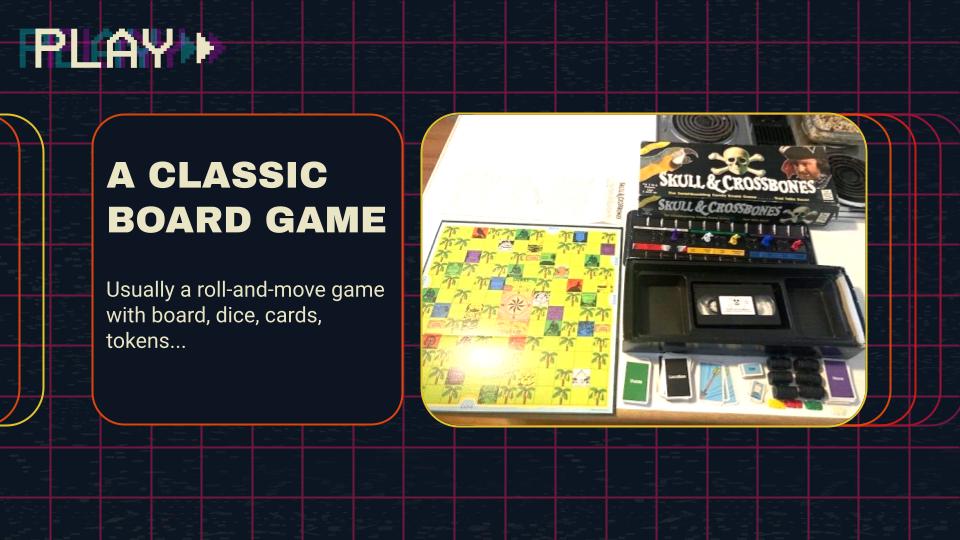
Imagine a classic roll-and-move, luck-based board game. You have a board, cards, dice, tokens, maybe a spinner…
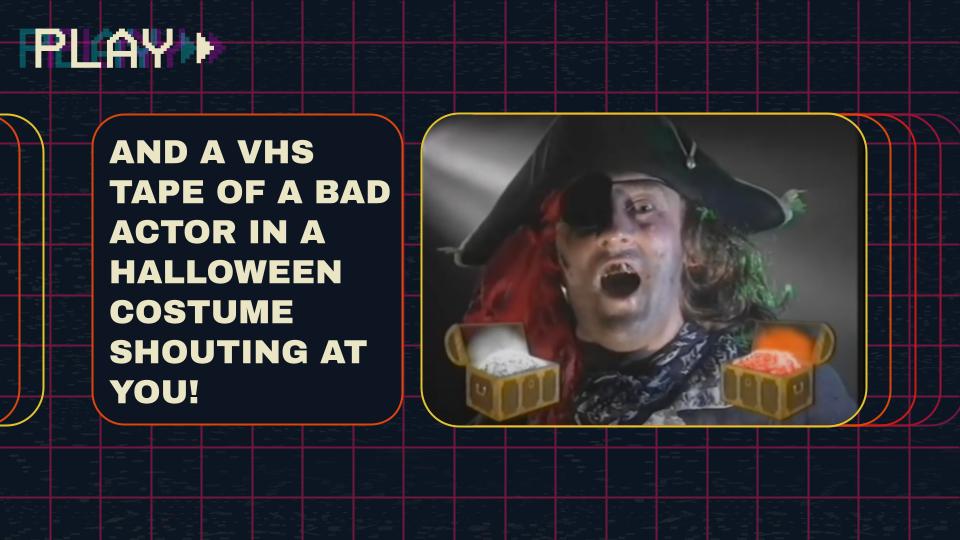
And a VHS tape! Of a guy screaming directly at you, the players! Think of the hosts like pre-recorded Dungeon Masters. They establish the game’s tone and theme, move the action along, and insert “random events” into the game to spice up the gameplay. Most of the tape is a timer counting down to the end of the game. (A timer would be an amazing component for Monopoly or Risk.)
Periodically, the host will interrupt the timer to throw a character into Red Square Prison or shower a player in Ghost Tokens. So while the host interjects at random feeling times, the tape is pre-recorded, so those events always happen at the same time. That’s why the replayability of these games is questionable. Once you’ve played it once, you won’t be surprised when the host tells you to stand-up and cluck like a chicken for a Treasure Card. He always does that at 31:48!
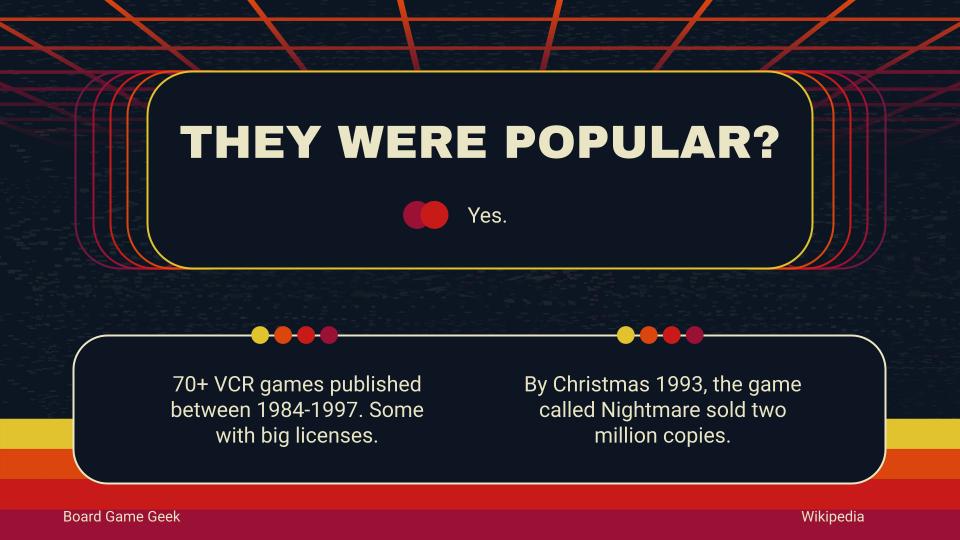
For a time, VCR games were pretty popular! They became an established form of home entertainment. Publishers made over 70 VCR games between 1984-1996, including games with major pop culture licenses like Wrestlemania, Robocop, and X-Files. Two popular sub-genres were mystery (Agatha Christie and Sherlock Holmes) and horse racing (why place real bets on real horses when you can place fake bet on fake horses that always do the same thing). The most iconic VCR game, Nightmare (aka Atmosfear) sold 2 million copies by Christmas 1993. More on Nightmare in just a bit. I wouldn’t do a talk on VCR games without a dedicated Nightmare slide. I’m not a monster, unlike the players in Nightmare!
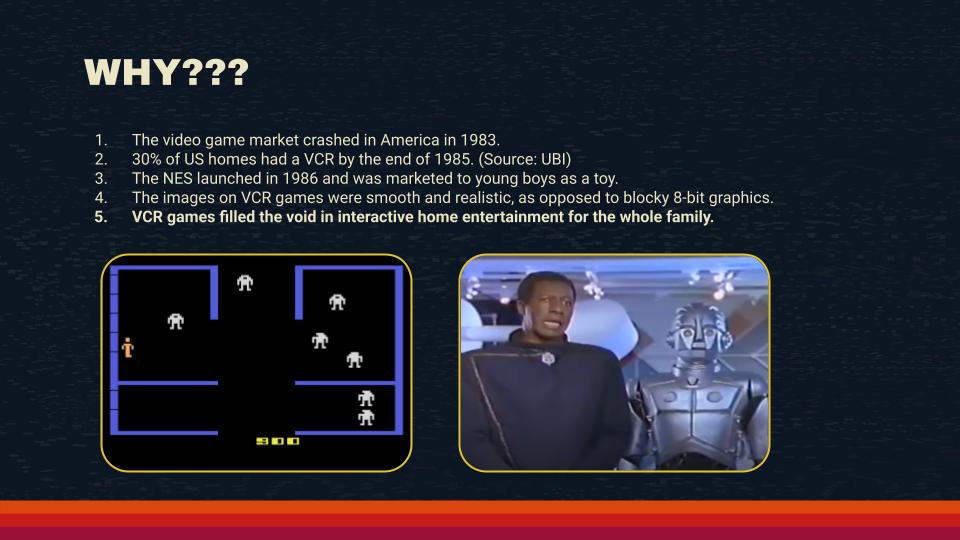
So why on earth did VCR games catch on? I did say earlier they’re not great games, and I stand by that cold take. As a category, “interactive home entertainment” was between gaming giants in the mid-80s. The home console market crashed in the US in the early 80s, taking out Atari and all the other major players. Nintendo Entertainment System was being marketed in America as a high-tech boy’s toy with a neat robot, not as a family gaming console. (Though, ironically, the name for the NES in Japan was the Famicom, a portmanteau of “family computer.”) 8-bit graphics on all systems at the time were still pretty blocky, as compared to a movie or TV show.
VCRs were becoming super popular. (The NES was designed to look like one.) VCR games, which offered realistic visuals because they were filmed, were largely marketed as interactive entertainment for the whole family. At least, at first. Later they would target niche audiences. These titles filled a niche in the gaming world for many years.
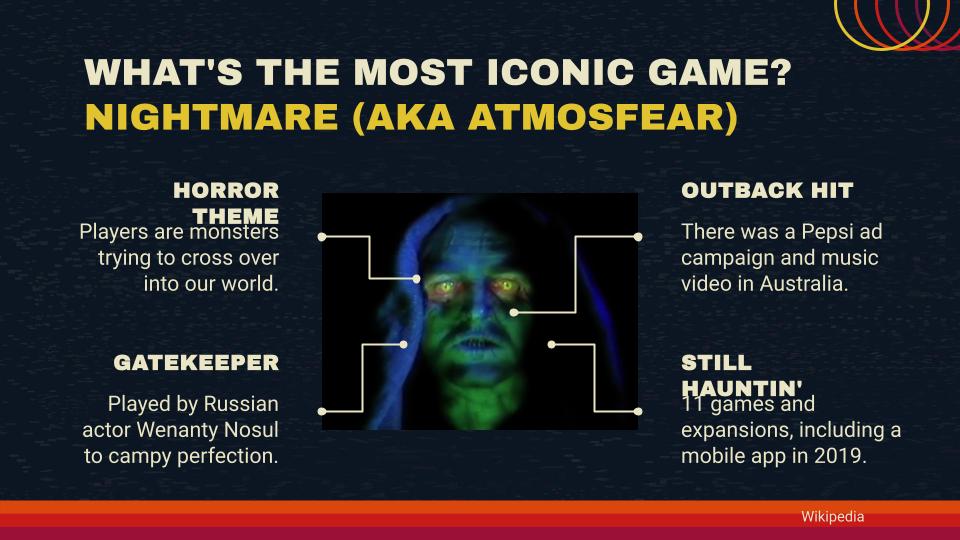
See? I promised you a Nightmare slide and I delivered. Remember that when you’re filling out your comment card.
So, yes, Nightmare (1991) is the best in show, in my opinion. Players take on the personas of horror characters (werewolves, mummies, etc.) and move around the board collecting keys, so they can escape from The Other Side into our world. The Gatekeeper, played by Russian actor Wenanty Nosul, plays the creepy, campy gravedigger to perfection. He punishes, taunts, and rewards players throughout the game.
As I said earlier, this franchise has sold in the millions, and includes 11 games and expansions in total. There was an Australian Kickstarter last year for a 30th Anniversary Edition that made over $300,000 USD. The game blew up in Australia with a Pepsi ad campaign and a music video. In fact, VCR games got so popular in Australia, there are ones like Myth made in Australia that are difficult to find in America. (Thank you, eBay! And thank you to my Australian friend Amanda, who digitized the tape of Myth at her local library, because my VCR can’t read PAL tapes!)
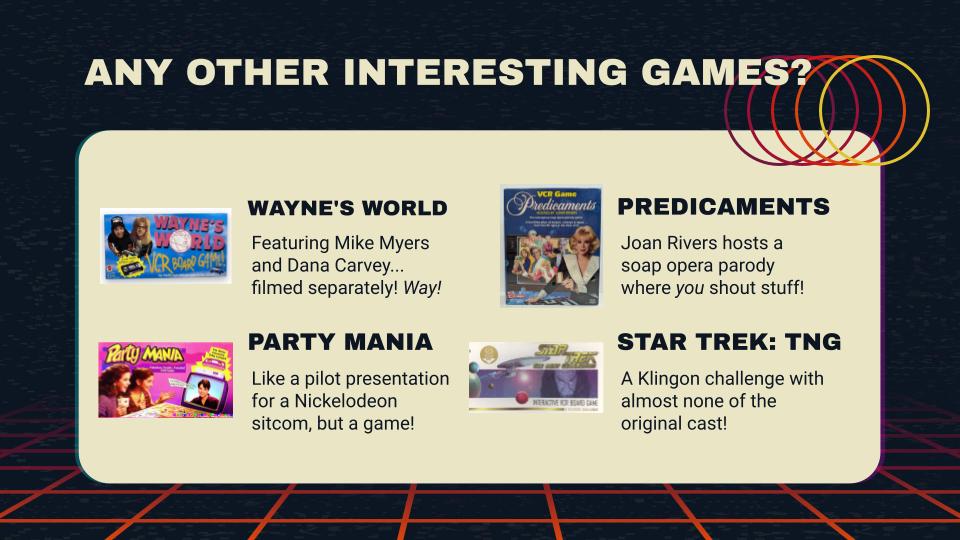
There are plenty of other interesting games besides Nightmare. These are the ones I recommend people watch on YouTube…
Wayne’s World VCR Board Game (1992) – You are certainly worthy for this one! Wayne’s World VCR Board Game features backstage passes, bodacious babes, all the catch phrases, and a mechanic where you crumble up balls of paper and throw them into the game box. Mike Myers and Dana Carvey were filmed in the same room together for the tape… NOT!
Party Mania (1993) – You’ve got to get all your chores done to go on a date with cute guys Max and Luke! It plays like a lost TGIF sitcom pilot. The game’s main antagonists are Wayne and Oscar Schlumper, the Schlumper Bros. They are nerds and they are astoundingly sweaty.
Predicaments (1986) – Hosted by Joan Rivers (!), players watch scenes from a parody soap opera and shout snappy answers at the screen, like a proto-MST3K. This game has the most unique mechanics of any VCR game I’ve played. A must for fans of the show Soap. Remember Soap? Billy Crystal? No? Alright, I’ll put together another presentation…
Star Trek: TNG – A Klingon Challenge (1993) – The Enterprise was stolen with you on-board. Beat a Klingon who is definitely not Worf to wrest back control. The ship is empty because of “maintenance issues,” but really because the game’s budget almost certainly wouldn’t allow for any actual cast members to appear on-screen, except the voice of Jonathan Frakes.
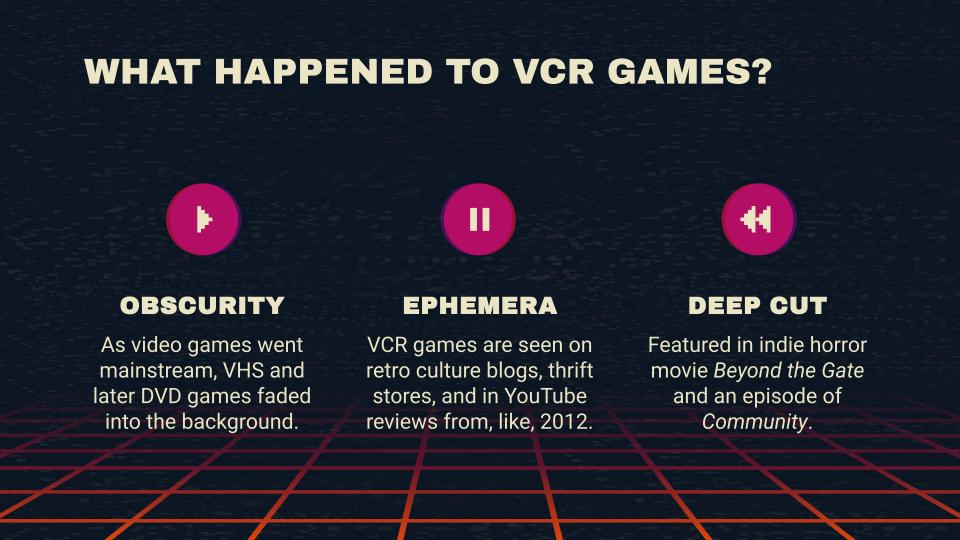
So, what is the legacy of VCR games? They were a temporary bridge from one era of home gaming to another. A “what if” in board game form. As VCRs faded in popularity, and video game graphics improved, these games were sold at Goodwills and front lawns for loose change. They’re the subject of old YouTube video reviews, an indie horror film that’s kinda boring, and a hilarious episode of Community.
Alright, and now to finally answer the question you’ve been wondering this entire time…
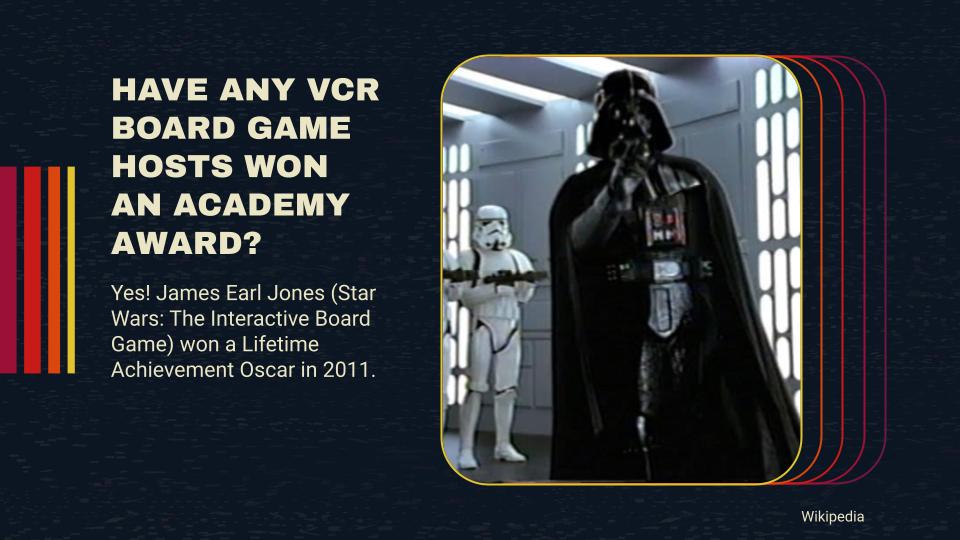
How many Oscars have VCR game hosts won? Collectively, I think they’ve won a total of one Oscar. I’m reasonably sure James Earl Jones is the sole winner in over a decade of VCR games. He voices Darth Vader in Star Wars: The Interactive Video Board Game. Jones received a Lifetime Achievement Oscar in 2011, but no awards for this game. That said, Mike Myers has a star on the Hollywood Walk of Fame and the Canadian Walk of Fame, and that should count for something.
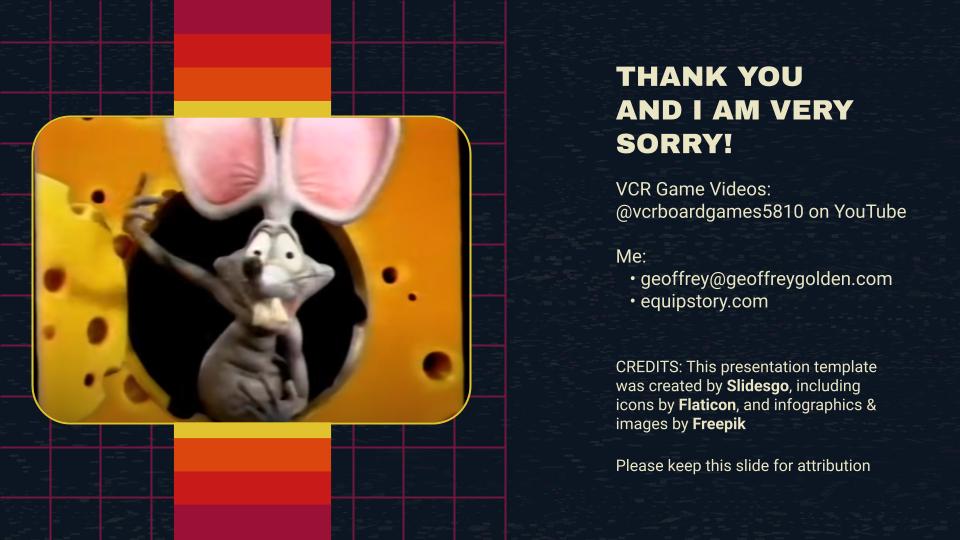
That was my presentation! And this is a picture of Rap Rat, which in my opinion is the worst VCR game video, although Spy Quest is also a rough watch. Rap Rat does not have bars. He should be barred… from existing. Okay, that’s enough of me. Thanks for reading!
🎲 Your Turn: Have you ever done a 5-minute presentation like this? If you have, what was your topic? If not, what topic would you want to present on? Reply directly to this email, or tell the whole world by hitting the big orange button below and leaving a comment.



12 responses to “Welcome to My (Useless) TED Talk”
I think the closest I’ve ever come to a 5-minute presentation was doing an impromptu speech for public speaking on why particle board is a horrible building material and should be banned. And while I’ve tried to keep copies of everything I’ve written for major school asignments, the whole point of the impromptu speech assignment in my Public Speaking class was making a speech without any kind of preparation(to the point that, where ass the other speeches for that class where scheduled and everyone in the class gave their speeches back-to-back over the course of several class meetings, the impromptu speeches where done piece meal through out the semest and you didn’t know when you’d have to do it until called on to do so).
Also, I wasn’t aware of either Clue VHS… then again, I was born in 86.
Though, reading this post, I can’t help comparing these to 2-XL and wondering how replay would improve if the VHS tapes could have used some kind of track switching. Like, instead of a static VHS tape playing, if you had a 2-XL program playing and at the end of each turn, the track is switched(one option would be for each player to just switch the track to the one corresponding to their player number, but you could also have things like board spaces or game cards instructing you to switch to a specific track… Makes me wonder how feasible it would have been to build a VCR that devides the screen into quadrants and feeds only 1 quadrant to the television at a time or some other method of trading image quality to fit multiple video streams together…
And of course, had the concept survived into the DVD days, you could have taken advantage of DVD’s ability to have multiple audio tracks and immediate scene skips to make things more interactive or to have a turn counter instead of a time counter… Of course, by the time DVD was displacing VHS, polygonal graphics were getting over their initial growing pains and 2-d graphics had reached the point of can handle just about anything an artist can draw.
Does make me wonder what could be achieved combining modern computer game tech with the tactile experience of traditional board games if cost wasn’t an issue. Like, imagine playing Mario Party but you have a physical game board and move your in-game avatar around the virtual board by moving physical pieces around the physical board, playing a strategy/Tactical RPG or RTS where you move units in-game by moving pieces on a D&D style battle map, or playing Magic, Yu-Gi-Oh, or Pokemon TCG with augmented reality head sets that project battle animations over the play area… Of course, the problem with such ideas is that video games have returned to their not adjusted for inflation 90s prices not counting paid DLC, modern board games more complicated from a manufacturing perspective than Chess often retail for as much as a new video game at launch, and proper integration of the two game styles means at best a very expensive non-standard peripheral that will struggle to get enough worthwhile games to justify its cost in the eyes of most gamers and at worst, a lot of bespoke electronics used by only one game… and I suppose this also intersects with the mention of non-standard game controls from a few posts back…
And one idea that my mind has gone back to many times over the last decade is a peripheral that consists of a square grid of physical toggle buttons where each grid cell can be in an up or down position and depending on the program, cells can be raised/lowered by user and/or computer controll… a 5*5 version as a tactile lights out game seems like a natural proof of concept, but I’ve also imagined things like using it for a gridded battle map, traditional board games played on a square grid, or a tactile version of Tetris or expanding the capabilities with retractable walls along grid edges or retractable pins at grid points. Like for a battle map, occupied cells are raised and you select units by pressing the cell they are in, the main well for Tetris is recessed with pieces raised and the preview is a recessed piece in a raised area representing the walls surrounding the well. and the walls and pegs could be used for things like indicating barriers on a battle map or perhaps a checkers game where the opponents pieces have walls around their spaces and kings are marked with the pegs… Sadly, I don’t know very much about custom electronics beyond having a vague idea of what a bread board is or even what the proper component name is for the kind of toggle switch I’m thinking of or if ones that can be electronically toggled are a thing in the world of custom electronics components… and it’s not exactly a cheap hobby to get into and to make matters worse, I’m pretty sure a lot of the kits for beginners focus on things like controlling led lights, not very blind accessible.
Funny enough, Hasbro was working on a device much like what you’re describing. NEMO was a VCR-based console that used built-in memory and image interlacing to allow switching back-and-forth between simultaneous images at the expense of image quality. NEMO never shipped, but the two games produced for the system – Night Trap and Sewer Shark – made their way to Sega CD.
There were DVD board games, actually. Lots of them! The most popular series by far was Scene It, but I have a Lilo & Stitch one and the bizarre History Channel Time Troopers starring John Cleese. But they never reached the kind of cultural cache VCR games did IMO, because of video game’s rapid ascent.
I agree that physical / video game hybrids are cool and it’s an area I’d like to explore. They do exist, but not at scale, probably for the reasons you outline here. For example, when Amanda and I visited the Nintendo Museum in Japan, they had a digital / physical hybrid version of Hanafuda that taught us how to play. We had real physical cards and placed them on digitally projected spaced, which read the cards and added up points. I would love something like that which was compatible with a lot of games.
Custom controller stuff is awesome. I’ve dabbled a little with Arduino, but I’ve only taken online classes and I think I’d learn better in an IRL workshop, which I have not been able to find in LA. It must be happening somewhere, but my research hasn’t come up with anything yet.
Two types of class I wish I had had more elective slots to take them when I was in college or could afford to return to college for fun to take are art classes and electronics classes. I was a computer science major, so I mostly took software related classes while in college and I never got the hang of a full-time course load, never mind the time-and-a-third or time-and-a-half required to actually complete a x year degree in x years, so even when I could afford classes my financial aid wouldn’t cover, it would be over committing and a dual Computer Science/ Computer Engineering major was off the table to maintain a healthy school/life balance… still, I wish I could afford to take classes for fun without caring if the class counts towards a given degree… and yeah, never cared for online courses, and I’ve always struggled with dedicated self study, so yeah, as far as I’m concerned, there’s no real substitute for a face-to-face classroom setting.
To follow your trail, I would talk about CassettePunk
Do you think its weird there is a worldwide consumption of “fidget spinners, clickers,etc”?
That is because our souls yearn for the tactile engagement of a switch, stolen from us in this world of touch screens and hand waving
We built temples called arcades in which we clicked, rolled, slammed, kicked, et all in the name of Cassettepunk
Even small mice could use a coin operated machine and get some cheese snacks… what have we done.
I’ve never heard the term CassettePunk before, but I do love my fidget spinner. It’s really helpful during a Zoom meeting to keep my focus.
I agree that touchscreens have left certain tactile experiences underrated and appreciated. That’s one thing I love about alt.play at GDC. It’s all about gaming with unusual tactile experiences. This year, I played a game that required me to dig my hands into a felt puppet!
Tapepunk is a new one on me too, but while I don’t have a fidget spinner, you’ll take my qwerty keyboard when you pry it from my cold, dead fingers… I also own a metallic purple zippo with no flint that’s never been fuelled purely because opening and closing it is a tactile and auditory delight. It is downright criminal that pocket computers are everywhere these days but almost none of them have a built-in physical keyboard and even when you connect an external keyboard, Android doesn’t seem to have any of the keyboard short cuts I’m used to being nearly universal on a desktop… and sadly, the pocket qwerty keyboard with integrated gamepad controls I own lacks a function key row, so I’m not sure it would work that well in practice if I ever get around to setting up my Raspberry Pi 5 with a full desktop install of Linux.
Have never done a presentation like that, nor been invited to an evening of them. Sounds fun. Maybe I would do a chat on… the emergency items we Californians must keep in our car trunks, seeing as how we spend so much time in our cars and quite possibly will be far away from home in our cars when The Big One™ hits! I suck at real life but I’m awesome in emergencies.
I should track down a VCR game, it’s been decades since I played one (but I did play a DVD game in the late 2000s). I currently have a VCR hooked up to my TV, too! It’s a Halloween tradition for me to watch my VHS of “Plan Nine From Outer Space” every year
Whoa, uh, real quick: What items should I have in my car? 😬
Oh yeah, if you already own a VCR, it’s worth having at least one VCR game for the sheer novelty. The ones I talked about here would probably run you $30-$50 on eBay. What DVD game did you play?
I did shorter presentations in my college public speaking class (I think I did one on why Moneyball was successful in baseball, this was 20 years ago before it became a thing the entire league adopted). I’ve spoken to my kids’ class and high schoolers about writing and publishing, but those were much longer than 5-minutes. If I had to do a 5-minute presentation now, it would be about how to make a comic book.
And your email has now jogged my memory, I had the Star Trek TNG interactive board game when I was a kid! And played it multiple times! This is nuts, I had completely forgotten about it.
How to Make a Comic Book would be a great talk! I find that not enough people know about / credit letterers for their important contributions.
Haha, I got that reaction from folks after I gave the talk. (“Oh my god, we had Nightmare!”) Hopefully those are good memories I helped resurface. ^_^
Absolutely! I tried doing some lettering myself and while I kind of got the hang of it, it took way too long and I just don’t have the right design eye, skills, or experience compared to a professional.
Yes, definitely good memories! Watching the Klingon say his opening lines was so surreal.
When you’ve memoryholed a piece of media, and then you see it again for the first time in many years, it’s a wild feeling!! (You can tell I haven’t done many drugs.)